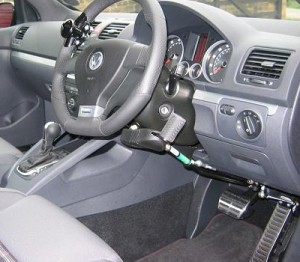In an excited rush for independence, people with spinal cord injuries often decide to purchase a vehicle before knowing what kind of adaptive equipment will need to go in it.
“One of the biggest mistakes people make is to buy the vehicle before consulting a driver rehabilitation specialist,” says Anne Hegberg, certified driver rehabilitation specialist at Marianjoy Rehabilitation Hospital.
rehabilitation specialist,” says Anne Hegberg, certified driver rehabilitation specialist at Marianjoy Rehabilitation Hospital.
The first step is to get an evaluation from a driver rehabilitation program. According to the National Highway Traffic Safety Administration, a standard evaluation tests:
• Muscle strength, flexibility, and range of motion
• Coordination and reaction time
• Judgment and decision-making abilities
• Ability to drive with adaptive equipment
• Vision and perception
After an evaluation, a driver rehabilitation specialist will determine the best equipment for you. Some of the most basic driving aids for people with spinal cord injuries include different variations of hand controls and steering controls. Extension controls also exist to give you a little extra reach if you have less strength in your arms, or if you are shorter than average. The adaptive driving aids you use are based on your level of injury, as well as personal preference. Once you find the right equipment, you’ll have a better idea of the type of vehicle you need and how much it will cost to install.
But not all adaptive driving equipment is created equal. Just because it works in one vehicle, doesn’t mean it will work in another. The type of vehicle you choose also makes a difference in the way you drive and how long it takes you to get in and out of the driver’s seat.
“A lot of guys don’t want to use a van,” Hegberg says. “However, loading and unloading your chair can be fatiguing.”
Conversion vans aren’t for everyone, but they make it easy to transfer from your wheelchair to the driver’s seat, or to drive directly from your wheelchair. Hegberg recommends the Ford full-size van. But if a min-van is more your style, the Toyota, Honda, Dodge, or Chrysler are also ideal.
Of course, you can also drive a car, such as a Sedan, as long as you have the upper-body strength to transfer to and from the wheelchair, store the wheelchair and open and close the door independently.
Here are some links to information about adaptive driving and vehicles:
- The Association for Driver Rehabilitation Specialists
- Adaptive Driving Alliance
- National Mobility Equipment Dealers Association
What are your experiences with adaptive driving? Please share your comments below.
I found your website this morning and want to congratulate you on a great site with so much great information. We are an advocacy organization that works with people who use home medical equipment of many varieties and we are always glad to see other great organizations like you. We want to make the SCI and mobility users we work with aware of your site. Keep up the good work!
Raising money to purchase vehicle for SCI individual. Would like for donors to have tax deduction for their contribution. Is there a foundation willing to accept donations for a project as this and direct funds to the designated recipient?